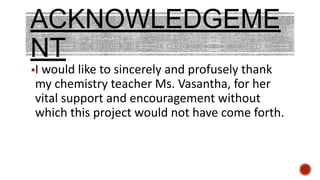
chemistry investigatory 2021-2022 (1) (2).pdf
- 1. ACKNOWLEDGEME NT ▪I would like to sincerely and profusely thank my chemistry teacher Ms. Vasantha, for her vital support and encouragement without which this project would not have come forth.
- 2. SATURATED SOLUTIONS:MEASURI NG SOLUBILTY ❑ CHEMISTRY ❑ TEJAS. R ❑ CLASS- 12 ‘B’ ❑ ACADEMIC YEAR 2021-2022 ❑ 12237
- 3. CERTIFICATE ▪This is to certify that TEJAS R of Class XII B has prepared the report on the Project entitled "SATURATED SOLUTIONS: MEASURING SOLUBILITY". The report is the result of his efforts & endeavors. The report is found worthy of acceptance as final project report for the subject CHEMISTRY of Class XII B. He has prepared the report under my guidance prescribed by CBSE for AISSCE 2021-2022. SIGNATURE OF SUBJECT TEACHER SIGNATURE OF EXTERNAL EXAMINER
- 4. INDEX SERIAL NUMBER 1 OBJECTIVE 2 INTRODUCTION 3 THEORY 4 MATERIALS 5 PROCEDURE 6 OBSERVATION 7 CONCLUSION
- 5. INTRODUCTION A good part of the substances we deal with in daily life, such as milk, gasoline, shampoo, wood, steel and air are mixtures.When the mixture is homogenous, that is to say, when its components are intermingled evenly, it is called a solution.There are various types of solutions, and these can be categorized by state (gas, liquid, or solid). Many essential chemical reactions and natural processes occur in liquid solutions, particularly those containing water (aqueous solutions) because so many things dissolve in water. In fact, water is sometimes referred to as the universal solvent.The electrical charges in water molecules help dissolve different kinds of substances. Solutions form when the force of attraction between solute and solvent is greater than the force of attraction between the particles in the solute. This Photo by Unknown author is licensed under CC BY.
- 6. MATERIALS: ▪ Distilled water ▪ liquid measuring cup (or graduated cylinder) ▪ Three clean glass jars ▪ Non-iodized table salt (NaCl) ▪ Sugar (sucrose, C12H22O11) ▪ Disposable plastic spoons ▪ Thermometer ▪ Three shallow plates or saucers ▪ Oven ▪ Electronic kitchen balance
- 7. OBJECTIV E: ▪To measure the solubilities of some common chemicals like Table salt [NaCl], Sugar or Sucrose [ C12H22O11].
- 8. THEORY: ▪ A saturated solution is a mixture in which no more solute can be practically dissolved in a solvent at a given temperature. It is said practical because theoretically infinite amount of solute can be added to a solvent, but after a certain limit the earlier dissolved solute particles start rearranging and come out at a constant rate. Hence overall it appears that no solute is dissolved after a given amount of solute is dissolved. This is known as a saturated solution. In an unsaturated solution, if solute is dissolved in a solvent the solute particles dissociate and mix with the solvent without the re-arrangement of earlier dissolved solute particles. Solubility depends on various factors like the Ksp of the salt, bond strength between the cation and anion, covalency of the bond, extent of inter and intramolecular hydrogen bonding, polarity, dipole moment etc. Out of these the concepts of H-bonding, covalency, ionic bond strength and polarity play a major role if water is taken as a solvent. Also physical conditions like temperature and pressure also play very important roles as they affect the kinetic energy of the molecules.
- 9. PROCEDURE: ▪ 1. Measure 100 mL of distilled water and pour into a clean, empty beaker or jar. ▪ 2. Use the kitchen balance to weigh out the suggested amount (see below) of the solute to be tested a. 50 g Non-iodized table salt (NaCl) b. 250 g Sugar (sucrose, C12H22O11) ▪ 3. Add a small amount of the solute to the water and stir with a clean disposable spoon until dissolved. ▪ 4. Repeat this process, always adding a small amount until the solute will no longer dissolve. ▪ 5. Weigh the amount of solute remaining to determine how much was added to the solution. ▪ 6. Try adding more solute at the same temperature and observe. ▪ 7. Heat the solutions and observe what happens when some more of solute is added.
- 10. OBSERVATIONS: Substance Amount of substance dissolved in 100mL of water to make saturated solution Moles dissolved NaCl 18.2g 0.311 C12H22O11 25.6g 0.074
- 11. RESULT: ▪The saturated solutions of NaCl and C12H22011 were made and observed. The observations agreed with the related theory within the range of experimental error.
- 12. CONCLUSI ON: The solubility of NaCI is the highest as it is an ionic salt and easily dissociates in water. Also since the size of both the cation and anion are small, the collisions are more and hence probability of dissociation is high. The solubility of C12H22O11 is the least as it a very large molecule due to which hydrogen bonding with the water molecules is not very effective.